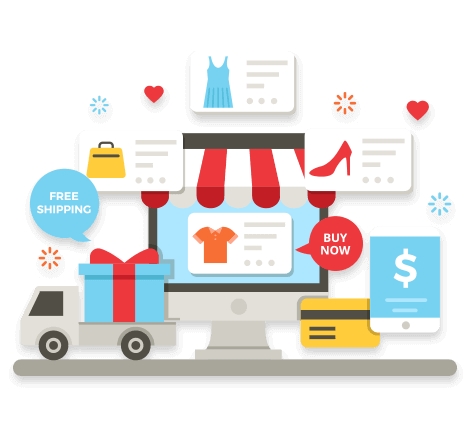
People enjoy shopping online for different reasons: it’s quicker, simpler, and less stressful, offers a broader choice, and, thanks to the range of exclusive deals, it’s always cheaper.
The way people interact with the outside world is evolving, and e-commerce is growing with it. Nevertheless, events change very rapidly in the COVID-19 pandemic. Modern e-commerce websites work as the bridge between how people buy in the market today and how they will buy in the future’s digitized market. The best approach is to incorporate some of the emerging developments in e-commerce design to help e-commerce businesses thrive, grow, and be commercially viable.
Let’s discuss various ecommerce design trends that companies will adopt in and after the COVID pandemic.
Striking Patterns, Catchy Typography
The new e-commerce design trends tell you to play more with bold, vibrant colors for eye-catching websites having colorful homepages. Using colors that communicate with consumers, express messages, and offer a positive shopping experience. Using fascinating typography and highlighted letters are an add on to this.
Focus On Mobile App E-commerce Than A Website Based
Gone are the days when designers concentrate on creating mobile device-adapted e-commerce websites. It’s a mobile technology age. A huge number of online shoppers prefer mobile shopping online. To capture the market, companies will rely on mobile e-commerce applications rather than the internet web.
Cyber-safety
About five years ago, malware threats and data breaches proliferated. Businesses today are investing more in website protection, ensuring consumers and employees that confidential data remains secure and encrypted. In 2020, e-commerce websites must buy HTTPS encryption and web application firewalls to improve trust when shopping online. Buyers need to have the trust that their confidential financial info is safe with the website. Cyber frauds, info leaks are more than ever nowadays. Thus a sound and safe system is required.
Animation
The animation is one of the most convincing ways to win website visitors’ attention. Our eyes naturally gravitate towards moving elements, so just take advantage of this pattern to push customers in the direction you want.
Develop your e-commerce app with cool buttons, rotating icons, and animated load bars that catch users’ attention—using GIFS as tiny images, repeat animations in homepage banners, and background images. As a theme, this year, you should expect more GIFS, advanced graphics, motion designs. Which means: Avoid using static images and make your stores more fluid, moving. Lay focuses on integrating images, animation, and micro-interactions. This will revive your online e-commerce shop.
There are various forms of motion to use on your site: micro-animations, product images, moving text, animated illustrations, etc. Don’t worry; you don’t have to go for compelling fully-produced videos—small launches. Too much action can confuse and annoy users of websites, and too many videos and moving elements can slow down the website pace.
AI Bots Chat
The biggest reason buyers are more hesitant to buy items online than in a physical store is that you can’t physically see or touch the stuff. That’s why chatbots are having a significant impact in 2020. They’re like digital assistants designed to answer common questions, making consumers more comfortable buying decisions. You can configure a pre-set chatbot around your items, shipping workflows, and more.
Not only do chatbots help shoppers understand your items, but they also help to understand shoppers. Most chatbot integrations include data and analytics. You will see what the customers are asking for and answer the questions they need. Chatbots proved so helpful that e-commerce platforms started offering them as add-ons.
Unorthodox Design
More and more brands step away from the usual grid and start experimenting with unconventional formats such as asymmetric or horizontal scrolling. They look more dynamic and interactive, showcasing a brand’s uniqueness. This pattern fits best with small-scale e-commerce shops. If there are several things on the show, it’s best to stick to the standard grid style. Otherwise, they’d take too much room and make it hard for a user.
Personalized Product Reviews
2020 is a personalization year, introducing a more ethical approach to handling customers. Try to be more personal to the product descriptions with sections such as usability tips, testimonials, or even quizzes, etc. These are convincing ways to list product features and a significant advance in e-commerce personalization.
360 Degree
Advanced graphics are more realistic. Instead of making a lot of images, you can make a 3D image using a 360-degree view to let you experience a product from multiple perspectives. AR, as an immersive alternative, now becomes a requirement as companies continue to adapt to COVID-19’s impacts.
Content-centered Design
Linking a product image to a product detail page is how you create your content-centered design. Include links to your goods in a blog post so that a mini-cart shows up, enabling shoppers to purchase or connect it to the cart right there as readers click by product name.
Initial Digital Product Photography

Everyone must have heard — A photo speaks 1,000 words. Add this is true to your ecommerce brochure – select beautiful high-quality, original pictures for your company. Minimize stock picture use. This is a year of innovative immersive multimedia technologies such as virtual reality (VR), augmented reality (AR), and 3D printing. It helps consumers to appreciate the commodity they are buying. This brings more sales and regular clients.
Stay ahead and emphasis on custom photography. Many businesses have started recruiting talented photographers to view authentic photos on their e-commerce websites.

Product Sizing Based on AR
AR-based product sizing helps in many industries where consumers can select product size without trying. AR-based product sizing occurs in 3 stages: sizing the customer’s body, sizing clothes or boots, and then putting the object on a virtual video or animated model. Today the fitting rooms come with the virtual reality, which also has data on fabric properties (stretching or color views from various angles), making models even closer to real-life shapes.
The virtual fitting rooms now use Vr, which helps consumers to wear clothing without trying. They can be rendered as appropriate rooms, virtual mirrors, or applications operated by digital cameras. Such booths have 3D body scanners that have the most accurate body measurements.

AR Service Navigator
It happens to almost every customer when he/she goes to a store and can’t find the commodity in the big mall. It can also be an issue for warehouse workers or sales representatives working in a retail store. We need to spend time identifying the items. Yet these things were a thing of the past.
A mobile app using an AR-based product navigator can easily find and take customers to find a product across product locations. This software is like a blessing for warehouses, groceries, and hyperlocal stores where delivery time is essential. There is no need to blindly find products one by one as it contributes to a wastage of time, which results in poor customer experience.

More Payment Options Window
Now we have multiple payment options. More of the latter tends to accommodate each section. Ecommerce stores accept cryptocurrencies. However, smartphone manufacturers use digital wallets. It simplifies e-commerce payment processes. Mobile commerce is also rising. The use of such alternative payment methods for mobile-based payments would increase.
Rapid technology development will push the e-commerce industry to make revolutionary new improvements to web designs and user interfaces. Give your e-commerce brochure template for stores a new look with 2020 ecommerce design trends. Futuristic web design and dive into e-commerce with a bang. Today, consumers are smart enough to sequester a professional medium design. Such patterns make the templates appealing, visually pleasing, and pave the way for long-term customer engagement.
